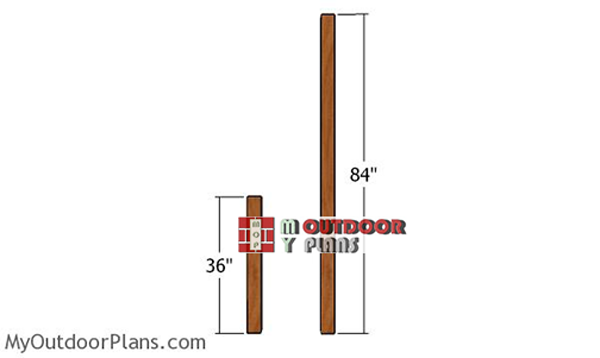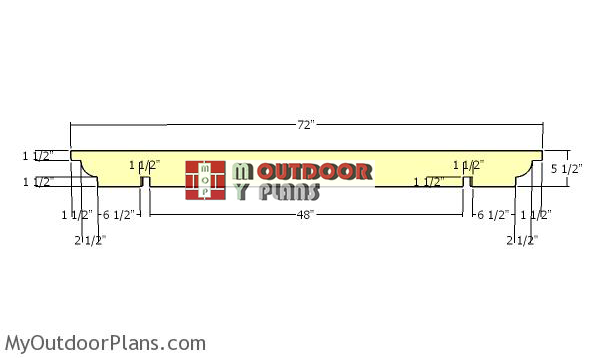This step by step diy project is about planter pergola plans. This 4×10 pergola / arbor features two large planters on both sides with the corresponding trellis. This is a simple weekend project that you could build on a small budget. You can adjust the size of the arbor, as well as the shape of the gable arch. Take a look over the rest of my woodworking plans, if you want to get more building inspiration.
All my woodworking plans come with 3D diagrams and step by step instructions. In addition, the plans include full Cut and Shopping lists. Remember that you need to read the local codes before starting the project. It is your responsibility to make adjustments and suit the legal requirements.
When buying the lumber, you should select the planks with great care, making sure they are straight and without any visible flaws (cracks, knots, twists, decay). Investing in cedar or other weather resistant lumber is a good idea, as it will pay off on the long run. Use a spirit level to plumb and align the components, before inserting the galvanized screws, otherwise the project won’t have a symmetrical look. If you have all the materials and tools required for the project, you could get the job done in about a day. See all my Premium Plans HERE.
Projects made from these plans
Planter Pergola Plans

Building-a-planter-pergola
Cut + Shopping Lists
- A – 4 pieces of 4×4 lumber – 36″ long, 4 pieces – 84″ long POSTS
- B – 4 pieces of 1×8 lumber – 41″ long, 4 pieces – 16″ long 2xPLANTER BOX
- C – 2 pieces of 2×2 lumber – 41″ long, 7 pieces – 18 3/4″ long 2xFLOOR
- D – 2 pieces of 2×8 lumber – 72″ long SUPPORT BEAMS
- E – 6 pieces of 2×6 lumber – 72″ long SIDE WALL
- F – 1 piece of 1×6 lumber – 41″ long, 5 pieces of 1×2 lumber – 42 1/2″ long, 5 pieces – 41″ long 2xLATTICE
- 4 pieces of 4×4 lumber – 8′
- 1 piece of 4×4 lumber – 12′
- 6 pieces of 1×8 lumber – 8′
- 2 pieces of 2×2 lumber – 8′
- 5 pieces of 1×6 lumber – 8′
- 2 pieces of 2×8 lumber – 12′
- 3 pieces of 2×6 lumber – 12′
- 10 pieces of 1×2 lumber – 8′
- 2 1/2″ screws, 3 1/2″ screws, 1 5/8″ screws, 1 1/4″ screws
- 3 1/2″ lag screws
- wood filler , wood glue, stain/paint
Tools
![]() Hammer, Tape measure, Framing square, Level
Hammer, Tape measure, Framing square, Level
![]() Miter saw, Drill machinery, Screwdriver, Sander
Miter saw, Drill machinery, Screwdriver, Sander
Time
Related
Planter Pergola Plans – Video
How to build a planter pergola

Building-the-posts
The first step of the project is to build the posts for the planter pergola. Cut the 4×4 posts as shown in the diagram.

Assembling the sides of the planter
Next, you need to add the 1×8 slats to create the sides the planter. Drill pocket holes at both ends of the slats and insert 1 1/4″ screws to lock them to the posts. Make sure you center the slats to the posts for a decorative effect. Leave no gaps between the slats.

Fitting-the-boards-to-the-planters-
Continue the project by attaching the slats to the front and back of the planter box. Drill pocket holes at both ends of the slats and secure them to the posts with 1 1/4″ screws.

Fitting the cleats to the planter box
Attach the 2×2 cleats to the interior of the planter box. Cut the cleats at 41″ and then fit them into place. Drill pilot holes and insert 2″ screws to lock them into place tightly.

Fitting the bottom slats to the planters
Use 1×6 boards for the bottom of the planter box. Cut the slats at the dimensions shown in the diagram and place them to the planter box, as shown in the diagram. Fit a 1″ wooden spacer between the boards for equal gaps. Drill pilot holes at both ends of the slats and insert 1 5/8″ screws to lock them into place tightly.

Making the notches to the end bottom slats
Make corner notches to the end bottom slats, so you can fit them around the corner posts. Smooth the edges with sandpaper.

Fitting the support to the top of the posts
Also, use a 1×6 board for the support that goes to the top of the tall posts. Drill pocket holes at both ends of the board and center it to the posts. Insert 1 1/4″ screws to secure the board into place tightly.

Building-the-support-beams
Next, build the support beams from 2×8 lumber. As you can see in the diagram, use a saw to make the angle cut at one end and a jigsaw to make the curved cut at the opposite end.

Gussets
Lay the support beams on a level surface and align the edges flush. Use a 1×8 board for the gussets. Drill pilot holes and insert 2″ screws to lock the components together tightly.

Attaching the support beams
Furthermore, fit the support beams to the top of the posts. Align the edges and clamp the beams to the posts. Drill pilot holes and insert 3 1/2″ lag screws.

shade-elements-planter-pergola
Additionally, use 2×6 lumber for the shade elements. Mark the cut lines on the boards and make the notches with a circular saw. Make the decorative cuts at both ends of the beams and smooth everything with attention.

Fitting the rafters
Also, fit the shade elements to the support beams. You can adjust the distance between the shade elements to suit your needs. Drill pilot holes through the shade elements and insert 6″ screws to lock them to the beams.

Fitting the horizontal supports for the lattice
Next, we need to build the trellis to the back of the planters, so you can grow climbing flowers. Cut the supports from 1×2 boards and drill pocket holes at both ends. Fit the supports to the back of the planters and insert 1 1/4″ screws to lock them into place. Place the supports equally spaced for a nice appearance.

Fitting the horizontal supports to the lattice
Fit the 1×2 slats to the back trellis supports. Make sure you use a scrap piece as a spacer, so you can get consistent result. Drill pilot holes and insert 1 1/4″ screws to lock the components together tightly.

How to build an arbor with planters
Last but not least, you need to take care of the finishing touches. Fill the holes with wood putty and then smooth the surface with 120-220 grit sandpaper. Apply a few coats of paint or stain over the planter pergola to protect the structure from the elements.

Planter pergola plans – front view
You can it plastic planters planters to the wooden boxes, or you could staple landscape material to the interior and then fill them with flower soil.

Planter Arbor Plans
If you like this design please share it with your friends using the social media widgets. If you build this pergola I would love to see your project and feature it on the blog. Make sure you take a look over the rest of my pergola plans, or you could check out the rest of my designs HERE.
This woodworking project was about planter pergola plans free. If you want to see more outdoor plans, check out the rest of our step by step projects and follow the instructions to obtain a professional result.
